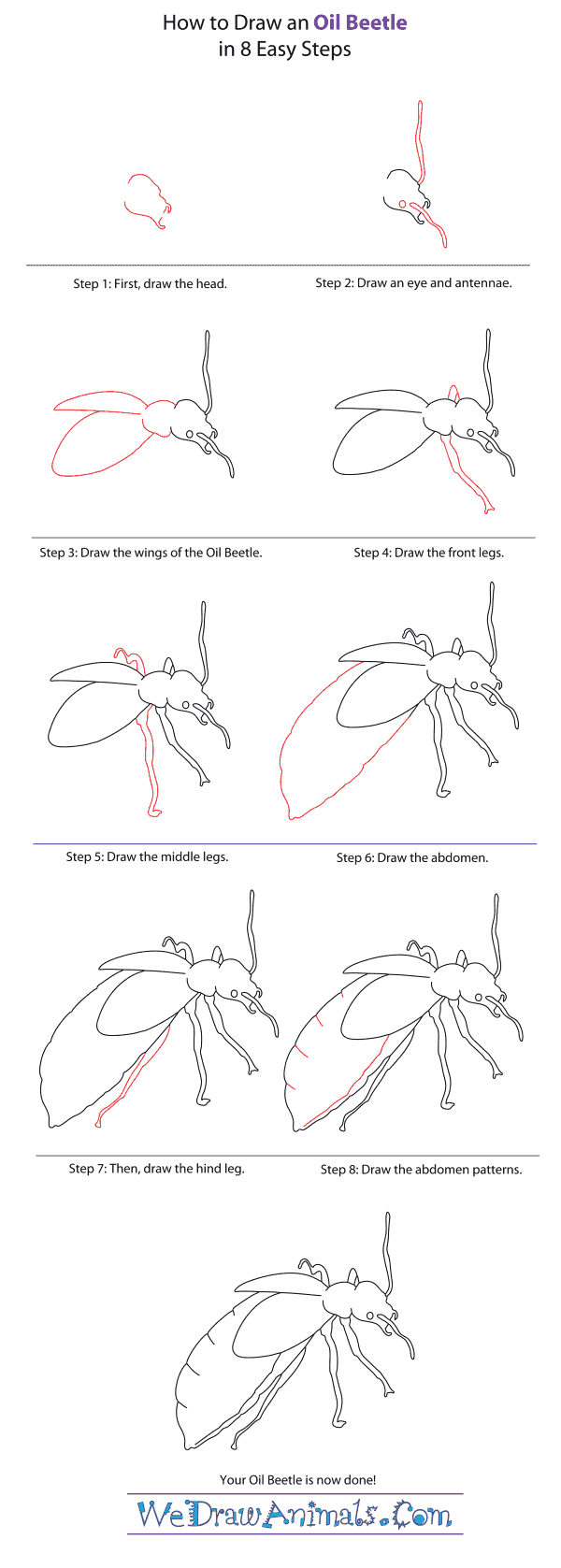In this quick tutorial you'll learn how to draw an Oil Beetle in 8 easy steps - great for kids and novice artists.
The images above represent how your finished drawing is going to look and the steps involved.
Below are the individual steps - you can click on each one for a High Resolution printable PDF version.
At the bottom you can read some interesting facts about the Oil Beetle.
Make sure you also check out any of the hundreds of drawing tutorials grouped by category.
How to Draw an Oil Beetle - Step-by-Step Tutorial
Step 1: The Oil beetle is very well-known by scientists for its interesting life-cycle. It relies on bees to carry their eggs for fertilization! To start drawing the beetle, Draw a pear shape with a space open in the back left, and two sharp curves for the mouth.
Step 2: Add a round circle for the eye, and two long tube shapes for the antennae. Close the antennae by a rounded end.
Step 3: Now to draw the wings, make a round shape for the rest of the body and then two long wing shapes. They should look like long round leaves.
Step 4: For the front legs, draw two more long downward and top it with some squiggly lines for feet. Add another leg at the top by making two small curved lines.
Step 5: For the middle legs, draw another, even longer set of lines down with a little curved hook part to the right for the foot. The add an 'm' shaped last leg to the top of the body.
Step 6: Now, for the abdomen, draw two long curved lines downward with a few bumps in it for detail.
Step 7: Draw the hind leg.
Step 8: Add the abdomen patterns. Female oil beetles are usually larger than the males, though some of the beetles can grow to be 35cmtotal!
Interesting Facts about the Oil Beetle
The oil beetle is a type of beetle that is native to Britain but is now only found in mostly the western parts of Britain as well as other small parts of Europe. The Oil beetle is most well-known by scientists for its interesting life-cycle.
Did you know?
- When it gets close to the end of spring a female oil beetle will digs holes near the ground where bees have colonies, and lay approximately 1000 eggs!
- The mother beetle plans the birth of the beetles to be around the same time as the bees emerge.
- The oil beetle larva will then climb onto flowers to wait for bees to arrive so that the larve can attach itself to the bee in hopes of being brought back into the bee’s burrow.
- When in the bee’s home the larva start to grow while being of the eggs of the bees as well as pollen collections before it pupates
- You can find these beetles in low-lying terrains in Europe and often on cliffs when in Britain.
- Female oil beetles are typically much larger than the males, though the beetles on average are a size varying between 11 to 35cm in total length









